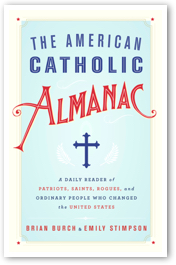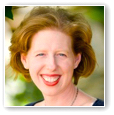Preface
- BRIAN BURCH AND EMILY STIMPSON
"What a joy it is to have The American Catholic Almanac in my home! This unique resource is a testament to the rich and diverse history of Catholicism in the United States." - Danielle Bean
 Books take you places you never expect to go. That's true for their readers, and it's doubly true for their writers. When you sit down to write a book, you think you know where you're headed. But along the way, something happens — obstacles arise, different paths open up, or new ideas present themselves. By the time you reach the end, you find precious little has gone as planned. And yet, you're incredibly grateful for that.
Books take you places you never expect to go. That's true for their readers, and it's doubly true for their writers. When you sit down to write a book, you think you know where you're headed. But along the way, something happens — obstacles arise, different paths open up, or new ideas present themselves. By the time you reach the end, you find precious little has gone as planned. And yet, you're incredibly grateful for that.
This book was no exception.
When we first set out to write The American Catholic Almanac, we wanted to accomplish two things. First, we wanted to tell the stories of the men and women who built the Catholic Church in America. Second, we wanted to demonstrate just how much America has benefited from what those men and women did. Our reasons for that were simple.
Many American Catholics have studied the history of the Faith in Europe and know about the lives of the saints who built the Church there. We know about the Crusades, the Inquisition, the martyrs of the English Reformation, and Saints Francis and Clare.
But for all that American Catholics know about Church history elsewhere, much of our own history remains a mystery. We don't know about the suffering and sacrifice that went in to building Catholic parishes in Maine and Catholic schools in Oregon. Only a few among us have heard of the Venerable Father Samuel Mazzuchelli, the great apostle of the Upper Midwest, or the Most Reverend Joseph Machebeuf, the first bishop of Denver. In most corners of America, the work of "The Angel of the Delta" — the laywoman Margaret Haughery — or "The Angel of Andersonville" — the priest Peter Whelan — has simply been forgotten.
Because we don't know those stories, because we don't know what those early American Catholics sacrificed, we also don't know how much we've gained. And that puts us at a serious disadvantage, especially when it comes to the ongoing debate over the place of religion in public life.
The American Catholic Witness
In the years that immediately preceded the American Revolution and for more than a century afterwards, America's dominant Protestant majority questioned the compatibility of Catholicism and democracy. They couldn't see how Catholics, with their "medieval superstitions" and papal loyalties, could be good citizens. Accordingly, many attempted — through both law and mob violence — to silence Catholic voices.
Ultimately, they failed. But today, anti-Catholicism has returned with a vengeance. Growing numbers of Americans again contend that Catholic voices don't belong in the public square, and growing numbers of Catholic dioceses again find themselves fighting legislation that limits Catholics' ability to practice their faith. Behind both those problems lurks a creeping militant secularism, which views religious faith in general (and the Catholic Faith in particular) as harmful to a free society.
The witness of the past, however, tells a different story than the polemics of the present.
That witness shows us Catholics, such as Saint Marianne Cope and Mother Frances Warde, building hospitals and schools for America's immigrants. It also shows us the Venerable Father Nelson Baker and Dorothy Day establishing institutions to serve the poor; Cesar Chavez and Lucy Burns fighting for the rights of the marginalized; Commodore John Barry and Rear Admiral Jeremiah Denton serving bravely in battle; and countless other Catholics living ordinary lives with extraordinary virtue.
The Catholic Faith wasn't incidental to what these men and women accomplished; it was central. It motivated and inspired them. It guided them. It shaped their thinking and formed their characters. You can't tell their stories without also telling the story of their faith. And you can't hear those stories without coming to a deeper understanding of what America owes to the Catholic Church.
Lessons for the New Evangelization
So, in the beginning, that's what we wanted to do — tell stories and demonstrate how the Catholic Faith helped shape America. We believe we've done that. But along the way, we found more than just greatness in the past. We also found guidance for the present.
In America and elsewhere in the West, the Christian faith is dying. According to a 2012 report by the Pew Research Center, "none" is the United States' fastest-growing religious affiliation, with one in five Americans now identifying as an atheist or agnostic. The Catholic Church has responded to that crisis of faith by calling for a "New Evangelization" — a renewed proclamation of the Gospel. Many within the Church, however, don't quite understand what the New Evangelization entails. All too often, Catholics find themselves at a loss about how best to lead others to Christ.
But the men and women in this book can show us the way.
In the lives of early American missionaries such as Bishop John Dubois, Bishop Simon Bruté, and Father John Bapst, we see conviction, not compromise. And in the lives of religious women such as Fanny Allen, Saint Frances Cabrini, and Saint Rose Philippine Duchesne, we see selflessness, not self-absorption. In the lives of both priests and religious, we see poverty, simplicity, and humble acts of service. We see men and women nursing victims of yellow fever and cholera, building parishes and schools, tending to the poor, and proclaiming the Gospel in the most dangerous and remote corners of America.
What we see are men and women who thought little about their own comfort and much about Christ.
Similarly, among the laity, we see Catholics such as Blessed Carlos Rodriguez, Venerable Pierre Toussaint, and Catherine Doherty, who lived what they believed. They incarnated the Church's teachings in the businesses they built, the laws they wrote, and the charities they founded. They prayed. They loved. They served.
And it worked, all of it — the humility, the service, the sacrifice. It won people to the Faith. It changed minds, and it transformed hearts. It built the Church in America from the ground up, giving rise to greater Catholic devotion and a flourishing Catholic intellectual life.
What worked once can work again — but only if Catholics know the stories of the people who made it work, only if we know our story as American Catholics.
What worked once can work again — but only if Catholics know the stories of the people who made it work, only if we know our story as American Catholics.
In the end, the best gift we received from writing this book was getting to know the men and women in these pages. They charmed us, amused us, inspired us, and encouraged us. They brought us to a deeper faith in Christ and a deeper love for the Church. Most of all, they helped us see what a great treasure we've received from those who went before us.
Without realizing it, we took much of that treasure for granted. We didn't fully know what we had. We didn't realize what a great blessing it is to call ourselves not Irish Catholics or French Catholics or German Catholics, but American Catholics. Now we do.
Perhaps, because so few of America's first Catholics have the title "Saint" before their name, we often forget that clouds of witnesses have lived on our shores. But they did. Through the centuries, countless holy men and women have called America home. There were far more of them than we could find room for in the 365 days covered in this almanac, and they did far greater things than we could do justice to in the limited space each entry afforded. Nevertheless, this is at least a start.
And we do need to start somewhere. For the more we get to know our spiritual forebears — the more we grow in friendship with them — the more we can continue the great work that they began. We can not only preserve our heritage as American Catholics but also cultivate it, enrich it, and pass on to future generations more, not less, than what we received.
 This is Meaghen Gonzalez, Editor of CERC. I hope you appreciated this piece. We curate these articles especially for believers like you.
This is Meaghen Gonzalez, Editor of CERC. I hope you appreciated this piece. We curate these articles especially for believers like you.
Please show your appreciation by making a $3 donation. CERC is entirely reader supported.

Acknowledgement

 Brian Burch and Emily Stimpson. "Preface." The American Catholic Almanac (New York: Image, 2014): 1-7.
Brian Burch and Emily Stimpson. "Preface." The American Catholic Almanac (New York: Image, 2014): 1-7.
Excerpted by permission of Image Books, a division of Penguin Random House. All rights reserved. No part of this excerpt may be reproduced or reprinted without permission in writing from the publisher.
For more information, visit ImageCatholicBooks.com.
The Author

 Brian Burch is president of CatholicVote.org, a nonprofit political advocacy group based in Chicago.
Brian Burch is president of CatholicVote.org, a nonprofit political advocacy group based in Chicago.
Emily Stimpson is a freelance Catholic writer based in Steubenville, Ohio. She is a contributing editor to Our Sunday Visitor Newsweekly, a blogger for CatholicVote.com, and a columnist for Lay Witness. Her books include These Beautiful Bones: An Everyday Theology of the Body, and The Catholic Girl's Survival Guide for the Single Years.
Together Brian Burch and Emily Stimpson have written The American Catholic Almanac: A Daily Reader of Patriots, Saints, Rogues, and Ordinary People Who Changed the United States.
Copyright © 2014 Image Catholic Books



